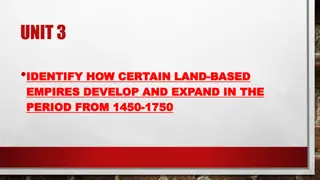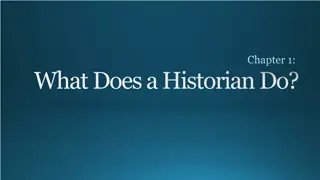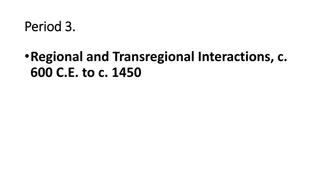600-1450 Major Developments and Continuities
In the period of 600-1450, significant developments occurred such as the spread of major religions, rise of new world religion Islam, establishment of Caliphates, and emergence of new trade systems. On the other hand, classical cultures persisted, slavery remained prevalent, and social structures saw little change. Global processes like trade routes and empires shaped interactions, while major civilizations in East Asia, South Asia, Southeast Asia, the Americas, West Africa, and the Swahili city-states thrived.
Download Presentation

Please find below an Image/Link to download the presentation.
The content on the website is provided AS IS for your information and personal use only. It may not be sold, licensed, or shared on other websites without obtaining consent from the author.If you encounter any issues during the download, it is possible that the publisher has removed the file from their server.
You are allowed to download the files provided on this website for personal or commercial use, subject to the condition that they are used lawfully. All files are the property of their respective owners.
The content on the website is provided AS IS for your information and personal use only. It may not be sold, licensed, or shared on other websites without obtaining consent from the author.
E N D
Presentation Transcript
600 1450 Major Developments Spread of Major Religions Rise of New World Religion - Islam Rise of Dar al-Islam Caliphates (Umayyad, Abbasid, Mamluk) New and more regular Trade Systems Trans-Saharan Trade Indian Ocean Trade (Monsoons) Silk Roads Mongol Empire Viking Explorations , Expansion, and Impact Pandemics 14thCentury
Continuities 600 - 1450 Classical cultures were maintained or revived Slavery continued to be a major part of many social systems and continued to be a major type of labor system There was no systematic change to social structures and political systems Ex. Landlords remained dominant in most societies Peasants continued to make up the bulk of the population
Global Processes 600-1450 Silk Road Trans-Saharan Trade Routes Indian Ocean Trade Routes Muslim Caliphates Mongol Empire Bubonic Plague
Major Civilizations 600 - 1450 East Asia: Tang, Song, Ming South Asia: Delhi Sultanate Southeast Asia: Vietnam The Americas: Maya, Aztec, Inca West Africa (Sudan): Ghana, Mali, Songhay Swahili City-States
632 Rise of Islam
732 Battle of Tours (end of Muslim move into France)
1054 1stSchism in Christian Church
1066 Norman conquest of England
1071 Battle of Manzikert (Seljuk Turks defeat Byzantines)
1095 1stCrusade
1258 Mongols sack Baghdad
1271-1295 Marco Polo Travels
1324 Mansa Musa s pilgrimage
1325 - 1349 Travels of Ibn Battuta
1347 - 1348 Bubonic plague in Europe
1433 End of Zheng He s voyages Rise of Ottomans
(750 C.E.) The Sunni dynasty that overthrew the Umayyads as caliphs
(632-634 C.E.) The first caliph; one of Muhammad's earliest followers and closest friends
The 4th caliph the cousin and son-in-law of Muhammad Caused warfare between the Sunnis and Shi'a for not punishing the murderer of the 3rd caliph, Uthman
Kingdom located in Ethiopian highlands; defeated the kingdom of Kush around 300 B.C.E. and succeeded by Ethiopia. Received strong influence from Arabian peninsula eventually converted to Christianity
(October 25, 732) Charles Martel, the Frankish Leader went against an Islamic army led by Emir Abd er Rahman; the Islamic army was defeated The battle stopped the northward advancement from Spain
Eastern Half of Roman Empire following collapse of western half of old empire retained Mediterranean culture, particularly Greek capital at Constantinople












